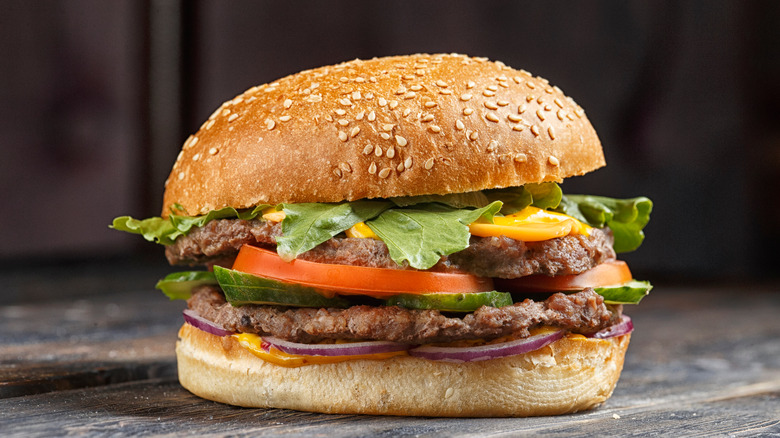The Dry-Aged Meat Combination To Level Up Your Next Burger
There are few things as emblematic of summer as the smoke and sizzle of burgers on the grill — and few recipes as unique to the individual chef as the ingredients that go into their humble burger. If you've mastered the basics and are looking to create your own signature hamburger, it's time to go beyond choosing the right ground beef and consider making burgers with a combination of different cuts of ground beef that have been dry-aged. The robustness of sirloin, juiciness of brisket, and beefiness of short rib will still be there, but with their flavors sublimely more refined and dense.
Dry aging essentially exposes beef to oxygen in a controlled environment over a period of weeks or even months. Doing this accomplishes several things: It concentrates the flavor by removing moisture and activating enzymes within the meat that break down molecular bonds and alter its texture. Aged beef has a nutty, complex flavor that freshly-ground cuts will never have. Think of it like the funky gloriousness of a good Roquefort as compared to a fresh sheep's milk cheese. Aged long enough, beef will develop a similar moldy flavor, although most dry-aging processes don't take it that far.
How to make an aged beef burger
Burgers made with dry-aged beef should be cooked a little differently than usual. Since we're not going to grind up expensive steaks to make burgers, the ground-aged meat will most likely come from the trim — the outer areas with higher fat content. (It's entirely possible to safely approximate the flavor of dry-aged beef at home, which might be more in line with your budget than shelling out around $20 a pound for the real thing). Ground fatty meat from the trim is ideal for making burgers because the delicious aged flavor will be prominent in your naturally juicy burgers.
Since you'll want to cook your dry-aged burgers over high heat long enough to render the fat and envelop them in a crisp crust, we recommend doing this in a very hot cast iron skillet, either on the stovetop or heated on the grill. But bear in mind that aged beef cooks more quickly than fresh, so be sure to check the doneness of your patties after about two minutes per side.
What should you serve with your aged beef burgers? Anything you want, but we like the idea of serving them with melted blue cheese, thinly sliced red onion, crisp Romaine lettuce, and sautéed mushrooms on a flash-grilled brioche bun. If you really want to go large, round out the meal with a glass of voluptuous vintage red wine like a Bordeaux or Barolo — a quick and delicious way to transform your patio into a 4-star restaurant.

